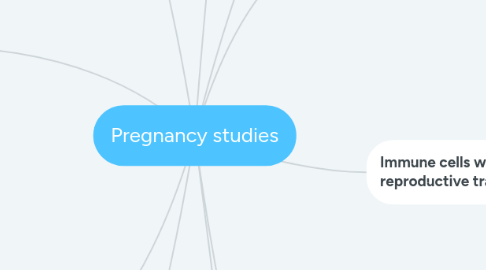
1. NK cells
1.1. Protect trophoblast bearing paternal Ag from maternal immune system
1.2. Protect mother from trophoblast invasion
1.3. REgulate restructuring of maternal spiral arteries
1.4. Protect uterus against infection
1.5. Dim and bright NK cells
1.5.1. Dim more effective in blood (90%)
1.5.1.1. High lytic activity
1.5.2. Bright mostly present in pregnancy
1.5.2.1. Low lytic activity
1.6. Found in large no. around endometrium and decidua
2. Immune response to semen
2.1. Seminal plasma modulates uterine environment to prevent rejection
2.1.1. Reacts to antigens within seminal plasma and priming the maternal immune system
2.1.2. Contains TGF-B, IL-8, IFN-G and prostaglandin E
2.2. Initial presentation of paternal alloantigens to maternal T cells after ejacuation is crucial for tolerance
3. Systemic and local immune suppression
3.1. Cytokine shift
3.2. Sex hormones
3.3. Uterine NK cells
4. Tregs and pregnancy
4.1. Treg numbers vary in uterus and increase during pregnancy
4.2. High in anticipation of transplantation
4.3. High during pregnancy
4.4. Tregs inhibit proliferation and cytokine production of CD4, CD8 and B cells
4.5. Tregs suppress Ig production, cytotoxic function of NK cells, maturation, DCs and macrophages
5. Effect of hormones on immune cells
5.1. Macrophages and dendritic cells
5.1.1. Accumulate after implantation around decidua
5.1.2. Suppressed or tolerogenic
5.1.3. Downregulated by estrogen and progesterone
5.2. Effect of sex steroids on lymphocytes
5.2.1. Estrogen and progesterone favour production of Th2 and inhibit Th1 polarisation
5.2.2. Estrogen causes a reduction in pre-B cells and IL-7 in bone marrow
5.3. T Cells
5.3.1. Progesterone and estrogen favour Th2 cytokines by T cells & inhibit Th1 cytokines
5.4. B cells
5.4.1. Reduction in pre-B cells and Il-7 responsive cells in bone marrow
5.4.2. Progesterone stimulates production of asymmetric Ab via PIBF
6. Maternal-fetal interface
6.1. Must promote tolerance to the fetus
6.2. Must maintain defence against pathogens
6.2.1. Fetal expressed paternal antigens are foreign to maternal immune system
6.2.1.1. Maternal immune system must tolerate the semi-allogenic fetus
7. Immune cells within female reproductive tract
7.1. Humans
7.1.1. Leukocytes
7.1.2. Organised lymphoid tissue
7.1.2.1. Influenced by progesterone and estrogen
7.1.3. Organised lymphoid aggregates
7.1.3.1. B cell core surrounded by T cells
7.2. Non pregnant uterus
7.2.1. Endometrium allows blastocyst implantation
7.2.2. Tissue remodelling ensures endometrium is ready for implantation window
7.2.3. Uterine mucosa undergoes regular changes in structure
8. Stages of pregnancy-
8.1. Implantation
8.1.1. Balance between pro and anti-inflammatory mechanisms during implantation
8.1.1.1. Blastocyst degrades endometrial extracellular matrix to invade uterus
8.1.1.1.1. Endometrial cells undergo apoptosis
8.2. Gestation- anatomical seperation
8.2.1. Muscle layer around uterus called myometrium
8.2.2. Placenta seperates blood flow between mother and baby
8.3. Partuition
8.3.1. Immune cells play important role in labour
8.3.2. Upregulation in chemokines and pathways regulating immune cell trafficking
8.4. Post-partum involution
8.4.1. Uterine mass must decrease rapidly through
8.4.1.1. Apoptosis
8.4.1.2. Neutrophil entry
8.4.1.3. Enzyme release
8.4.1.4. Phagocytosis of cellular debris
9. Pregnancy infection
9.1. Have direct effect on pregnancy
9.1.1. Placenta damage
9.1.2. Congenital transmission
9.1.3. Neurodevelopmental changes and neuropsychiatric diseases
9.2. Pregnancy can alter immunity to infection
9.2.1. Increased susceptibility to new infections
9.2.2. Reactivation of latent infections

